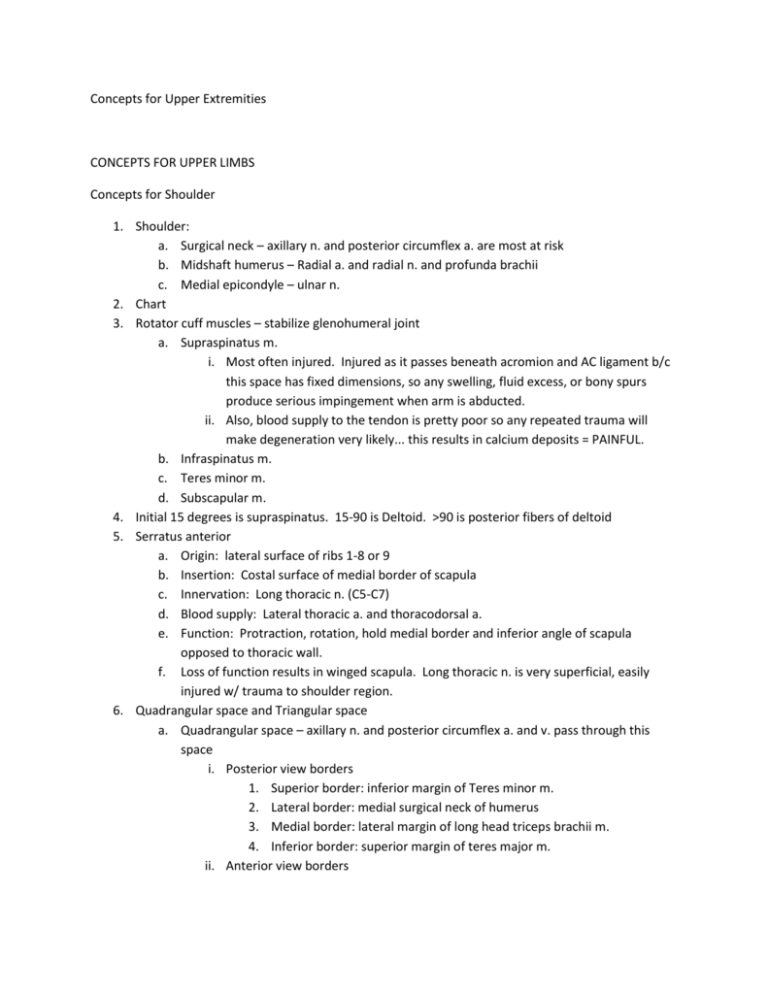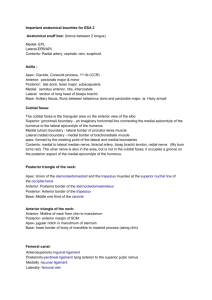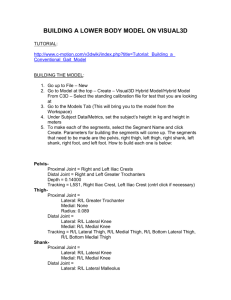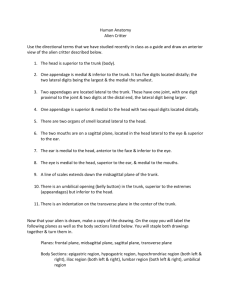Concepts for Upper Extremities
advertisement

Concepts for Upper Extremities CONCEPTS FOR UPPER LIMBS Concepts for Shoulder 1. Shoulder: a. Surgical neck – axillary n. and posterior circumflex a. are most at risk b. Midshaft humerus – Radial a. and radial n. and profunda brachii c. Medial epicondyle – ulnar n. 2. Chart 3. Rotator cuff muscles – stabilize glenohumeral joint a. Supraspinatus m. i. Most often injured. Injured as it passes beneath acromion and AC ligament b/c this space has fixed dimensions, so any swelling, fluid excess, or bony spurs produce serious impingement when arm is abducted. ii. Also, blood supply to the tendon is pretty poor so any repeated trauma will make degeneration very likely... this results in calcium deposits = PAINFUL. b. Infraspinatus m. c. Teres minor m. d. Subscapular m. 4. Initial 15 degrees is supraspinatus. 15-90 is Deltoid. >90 is posterior fibers of deltoid 5. Serratus anterior a. Origin: lateral surface of ribs 1-8 or 9 b. Insertion: Costal surface of medial border of scapula c. Innervation: Long thoracic n. (C5-C7) d. Blood supply: Lateral thoracic a. and thoracodorsal a. e. Function: Protraction, rotation, hold medial border and inferior angle of scapula opposed to thoracic wall. f. Loss of function results in winged scapula. Long thoracic n. is very superficial, easily injured w/ trauma to shoulder region. 6. Quadrangular space and Triangular space a. Quadrangular space – axillary n. and posterior circumflex a. and v. pass through this space i. Posterior view borders 1. Superior border: inferior margin of Teres minor m. 2. Lateral border: medial surgical neck of humerus 3. Medial border: lateral margin of long head triceps brachii m. 4. Inferior border: superior margin of teres major m. ii. Anterior view borders 1. Inferior margin of subscapularis m., surgical neck of humerus, superior margin of teres major m. and lateral margin of long head of tricpes brachii m. b. Triangular space – circumflex scapular a. and vein pass through this space (into anterior view) i. Posterior view borders 1. Superior border: inferior margin of teres minor m. 2. Lateral border: medial margin of long head triceps brachii m. 3. Inferior border: superior margin of teres major m. ii. Anterior view borders 1. Medial margin of long head of triceps brachii m., superior margin of teres major m., and inferior margin of subscapularis m. c. Triangular interval -- profunda brachii a. and veins, and RADIAL n. pass through here. (into posterior compartment) i. Superior border: inferior margin of teres major m. ii. Lateral border: shaft of humerus iii. Medial border: lateral margin of long head of triceps brachii m. 7. Anastomoses of shoulder a. Suprascapular a., subscapular a., posterior and anterior circumflex humeral a., circumflex scapular a. all form anastomoses around the shoulder. b. If you ligate axillary a. superiorly to Profunda brachii a., no blood flow to distal arm. Inferiorly to profunda brachii a., allows blood to flow to distal arm via profunda brachii a. 8. Clinical correlates: Concepts for Axilla and Pectoral 1. Axilla – provides communication/transition from neck to arm. a. Anterior wall: pectoralis major and minor m., subclavius m. and clavipectoral fascia b. Lateral wall: intertubercular sulcus c. Posterior wall: subscapularis m., teres major m., latissimus dorsi m., long head of triceps brachii m. d. Medial wall: upper thoracic wall, serratus anterior m. e. Floor: armpit skin and claviopectoral fascia w/ anterior axillary fold superior to posterior axillary fold. f. Inlet: lateral margin of rib 1,clavicle, superior margin of scapula to coracoids process i. Inlet houses the axillary sheath that surrounds arteries, veins, nerves, and lymphatics. g. Contents of axilla 2. P 685 GT 3. Axillary artery a. 1st part i. Superior thoracic a. – small and originates at anterior surface. Supplies upper regions of the medial and anterior axillary walls. nd b. 2 part i. Thoraco-acromial a. – short and originates at anterior surface. Curves around the superior margin of pectoralis minor m. and penetrates clavipectoral fascia. Branches and supplies anterior axillary wall and related regions: 1. Pectoral – also contributes to vasculature of breast 2. Deltoid – passes into clavipectoral triangle to accompany cephalic vein, and supplies adjacent structures. 3. Clavicular 4. Acromial ii. Lateral thoracic a. – arises from anterior surface. Supplies medial and anterior walls of axilla. In women, branches emerge from around the inferior margin of pectoralis major m. to contribute to the vasculature of breast. rd c. 3 part i. Subscapular a. – largest branch of axillary a. and major blood supply to posterior wall of axilla. 1. Circumflex scapular a. – passes through triangular space. Pierces the origin of teres minor and enters infraspinous fossa to anastomoses with suprascapular a. and deep branch of TCA. 2. Thoracodorsal a. – follows lateral border of scapula to inferior angle and contributes to supply of posterior and medial walls of axilla. ii. Anterior circumflex humeral a. – small and originates from lateral side of 3rd part of axillary a. Anastomoses with posterior circumflex humeral a. iii. Posterior circumflex humeral a. – lateral surface of 3rd part of axillary a. posterior to origin of anterior circumflex humeral a. Passes through quadrangular space and supplies gleno humeral joint and surrounding m. Anastomoses w/ anterior circumflex humeral a., branches from profunda brachii, suprascapular, and thoraco-acromial a. 4. Axillary vein a. Cephalic 5. Formation of superficial and deep arterial arches relative to their origin, major contributors, size, location in palm, branches provided in palm and fingers. Where are they susceptible to injury and palpation? Ulnar arterty and superficial/deep palmar arch (Gray’s Text p. 767, diagram on p. 768) Blood supply to hand is from radial and ulnar arteries that form 2 interconnected vascular arches in the palm. Radial artery contributes substantially to supply thumb and lateral saide of index finger while remaining digits and medial side of index are supplied mainly by ulnar artery. - - Ulnar a. enters hand on the medial side of wrist and lies between Palmaris brevis and flexor retinaculum, lateral to the ulnar n. and pisiform bone. Ulnar arter is medial to the hook of the hamate bone and then swings laterally across palm to form SUPERFICIAL PALMAR ARCH. o Superficial palmar arch is superficial to long flexor tendons of digits and just deep to palmar aponeurosis. o Laterally, the arch communicates with palmar branch of radial a. o Branches of superficial palmar arch Palmar digital artery to medial side of little finger 3 Common palmar digital arteries providing main blood supply to lateral little finger, bilateral ring and middle fingers, and medial side of index finger. Deep arch palmar metacarpal arteries join the common palmar digital arteries and then bifurcate into the PROPER PALMAR DIGITAL A. that enter the fingers. Ulnar a. branches just distal to pisiform and penetrates the origin of hypothenar muscles forming DEEP PALMAR ARCH o Deep palmar arch curves medially around the hook of the hamate to access deep plane of palm and anastomose with deep palmar arch derived from radial a. Radial artery and deep palmar arch - - - Radial artery curves around lateral side of wrist and passes over floor of the anatomical snuff box into deep plane of palm by penetrating anteriorly through back of the hand Passes btwn 2 heads of the 1st dorsal interosseous m. and then btwn 2 heads of adductor pollicis m. and forms the deep palmar arch Deep palmar arch passes medially through the palm between metacarpal bones and long flexor tendons of the digits On medial side, communicates with the deep palmar branch of the ulnar a. o Deep palmar arch gives rise to: Palmar metacarpal arteries that join the common palmar digital arteries from superficial palmar arch 3 perforating branches that pass posteriorly btwn heads of origin of dorsal interrosesou to anastomose with dorsal metacarpal arteries from dorsal carpal arch Prior to penetrating the dorsal aspect of hand, radial a. branches into 2 vessels o Dorsal carpal branch – medially passes as the dorsal carpal arch across the wrist while giving rise to the branches of the dorsal metacarpal arteries that divide into small dorsal digital arteries that enter fingers o 1st dorsal metacarpal artery – supplies adjacent sides of index finger and thumb The radial artery runs between the 1st dorsal interosseous and adductor pollicis and gives rise to princeps pollicis artery and radialis indicis artery. o Princeps pollicis artery – major blood supply to thumb o Radialis indicis artery – supplies lateral side of index finger - Injury - ? Assuming most vulnerable is the superficial arch. Easily seen in palm of the hand. Can palpate in thenar eminence. Motor and Sensory distribution of nerves of the hand (p. 771 in Gray’s Text): - - - Dermatomes: mainly C8 and T1 innervate the hand Ulnar n. o Deep branch (MAINLY MOTOR) passes with deep branch of ulnar a. supplying the hypothenar muscle, interossei adductor pollicis, 2 medial lumbricals and small articular branches to the wrist joint. * passes through Guyon’s canal btwn hook of hamate and flexor tendons. If ganglia from the joints compress the nerve within Guyon’s canal, sensory and motor symptoms o Superficial branch (MAINLY SENSORY) innervates Palmaris brevis m. and skin on palmar surface of little finger and medial half of the ring finger o Injury to ulnar n. most common at elbow and at wrist. These injuries are characterized by “clawing” of the hand – metacarpophalangeal joints of fingers are hyperextended and interphalangeal joints are flexed. Seen most drastically in medial fingers and adductor pollicis muscle function is gone. Lesion at elbow = function of flexor carpi ulnaris m. and flexor digitorum profundus to medial 2 digits is lost as well Ulnar n. lesion at wrist makes clawing of little and ring fingers worse than if at elbow. Evaluate state of function of the dorsal branch (cutaneous) of the ulnar n.... which originates in distal regions of forearm. Median n. o MOST IMPORTANT SENSORY NERVE in the hand. o Innervates skin on the thumb, index and middle fingers, and lateral side of the ring finger. (like we learned in OMM about how first 3 fingers are most sensitive) o Innervates the thenar muscles responsible for opposition of thumb. o Enters hand via carpal tunnel and branches – Recurrent branch and palmar digital branches. Recurrent branch – innervates 3 thenar muscles Palmar digital – innervate skin on palmar surfaces of lateral 3 and ½ digits and cutaneous regions over the dorsal aspect of distal phalanges (nail beds). Also supply lateral 2 lumbrical muscles. Superficial branch of radial n. o Only superficial branch of radial n. enters hand. o Terminal branches can be palpated against tendon of extensor pollicis longus as they cross over anatomical snuffbox. o Innervates skin over dorsolateral aspect of palm and dorsal aspects of the lateral 3 and ½ digits distally, to about the terminal interphalangeal joints. Injury at elbow joint – at the elbow, radial nerve splits into superficial and deep branch. Most common injury is damage to nerve in radial groove of humerus that produces global paralysis of muscles of posterior compartment = WRIST DROP Radial n. damage can be from fx of shaft of humerus. Injury will produce reduction of sensation in the cutaneous distribution (posterior aspect of hand) If posterior interosseous n. (continuation of deep branch of radial n.) is severed, muscles of posterior compartment of forearm may be paralyzed... typically the patient may not be able to extend fingers. Radial n. running across anatomical snuffbox can be damaged, but this has little consequence b/c of small area of coverage done by this branch.









